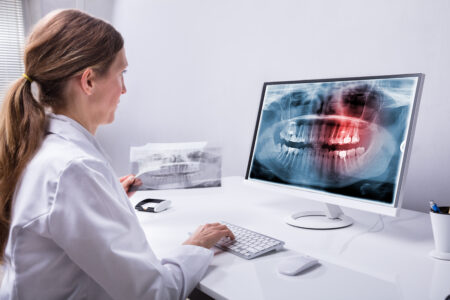 So much of the oral health field is centered around visual clues and signs. Examinations rely both upon physically looking at the teeth and other structures of the mouth, but they also require more sophisticated imagery.
So much of the oral health field is centered around visual clues and signs. Examinations rely both upon physically looking at the teeth and other structures of the mouth, but they also require more sophisticated imagery.
Today, your Overland Park, KS dentist writes to you about some of the more common forms of photography and images dentists use to identify problems in your mouth!
X-Rays Are Most Common
When it comes to the types of images we utilize in the office, the x-ray is the most common. Also known as a radiograph, this shows us areas of density, primarily in bone and tooth matter.
These can see cavities as they develop, even in areas of the mouth that are not readily available to the hands and eyes of a dentist. The degradation of any material, such as an infection within the structure of the tooth, can be seen with x-rays. Typically, a dentist uses what is known as a bitewing x-ray for this sort of exam.
Also, the incoming teeth can be seen within the bone of the jaw. Misalignment of adult teeth or wisdom teeth can be spotted in children and adolescents with a different angle of photography, from the side of the mouth.
Is It Safe?
Due to the low level of radioactive material, x-rays can give some patients pause. After all, isn’t it dangerous to have that near your brain?
Simply put, the levels are much too low to affect that of an adult human. That said, if you are pregnant or believe you may be, be sure to let your dentist know. Fetuses are not as strong and the development can be affected by an image.
Advances Happen Daily
When it comes to the myriad of available image options for dentistry, new technology is always evolving. Previously, x-rays required film development, much like older photographs.
Today, digital radiography has emerged as a vital tool for oral health care professionals. There is less time and mess involved in the procedure. And due to the ability to make numerous prints simultaneously, dentists can get better and more in-depth views of your smile.
Also, the quality of the radiographs has improved significantly over the past few years. This can limit the amount of necessary trauma for any oral surgery. For instance, a more accurate knowledge of the structure of a weakened tooth may result in a procedure that removes less natural tooth.
Optimally, dentists like to keep as much bilogoical matter as is possible to maintain a safe smile. These images allow us to do that, and we look forward to serving you using the latest technologies on the market!
Call Us For More Information!
Contact Family First Dental in Overland Park, KS by calling 913-381-2600 to schedule your next appointment with our team and discuss how we can plan to protect your teeth as best as possible!
